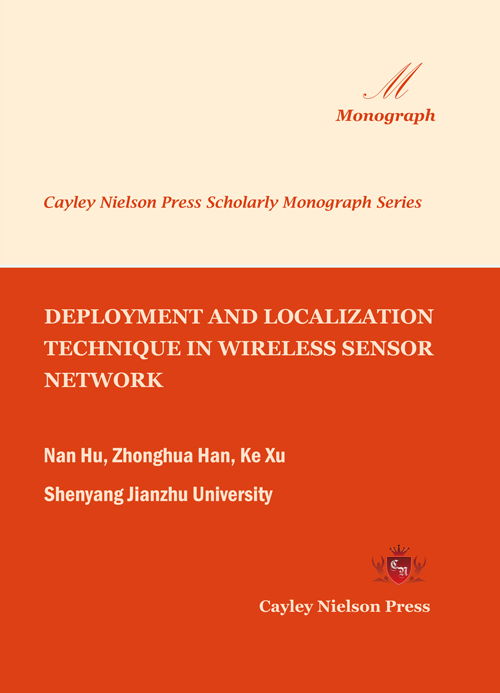
DEPLOYMENT AND LOCALIZATION TECHNIQUE IN WIRELESS SENSOR NETWORK

Nan Hu, Zhonghua Han, Ke Xu
Shenyang Jianzhu University
Copyright © 2020 by Cayley Nielson Press, Inc.
ISBN: 978-1-7348822-2-3
Cayley Nielson Press Scholarly Monograph Series Book Code No.: 210-9-9
US$190.50
Preface
Recent advances in micro-electronic, computing and wireless communication technologies have enabled the rapidly development of low-power and multi-functional wireless sensor network (WSN). Since the WSN has a wide range of applications such as battlefield surveillance, environment monitoring and disaster relief operations, it has attracted considerable research interest. Research on indoor localization and network maintenance issues are one of the most difficult problems for WSN properties research.
Localization as a key technology of WSN is applied widely. Due to the flexibility of WSN, it becomes a powerful supplement of the Global Positioning System (GPS), especially when locating target indoors. The scheme can achieve high localization accuracy in an ideal environment. However, in practical scenario there must be some errors. As the major challenge of localization, non-line-of-sight (NLOS)error occurs when the propagation of the signal is obstructed by some unknown obstacle. NLOS error decreased the localization performance more severely. Eliminating the negative effect of NOLS error raises great attraction in recent years.
Another fundamental issue in sensor network is the coverage problem because it directly relates to optimization of resources in the field. Since the distributions of sensor nodes are not usually uniform, random deployment and node failures, the coverage holes are hardly avoided in sensor network. The coverage holes may affect the network connectivity and may result in losing the sensed data. And the coverage holes are important health indicators of the sensor network. The contents of the book are organized into six chapters.
In chapter 1, the survey of localization in wireless sensor network is introduced. In chapter 2 is about the essential ones of triple-filters NLOS localization algorithm based on fuzzy C-Means for wireless sensor network. In chapter 3 is about the essential ones of the fuzzy C-Means and hierarchical voting based on RSSI quantify localization method for wireless sensor network. In chapter 4, the essential ones of studying on indoor localization strategy for mini-UAV in presence of obstacles. The chapter 5 is about the residual analysis based on improved particle filter in mobile localization. The last chapter is about the method of detece the coverage holes by using level set and heal the holes.
I wanted to thank the authors of the book chapters, especially Xi-feng Guo, Yu Ying, Rui Zhang, Mei-Ju Liu, Jing Hou, Ying Zhang, Jin-xiang Pian, Xiaoxi Tian, Yunning Feng, Rongjian Wei because they offered to the technology of the wireless sensor networks applied to many areas of the latest progress and the existing challenges.
Nan Hu
Shenyang Jianzhu University
Shenyang,Liaoning, China
July 13,2020
Contents
Preface................................................................................................I
Chapter 1 A Review of Localization in Wireless Sensor Network..........................................1
1.1 Introduction........................................................................................1
1.2 Target/Source Localization..........................................................................3
1.2.1 Single-Target/Source Localization in Wireless Sensor Network......................................3
1.2.2 Multiple-Target Localization in Wireless Sensor Network............................................5
1.2.3 Single-Target/Source Localization in Wireless Binary Sensor Network................................8
1.3 Node Self-Localization................................................................................9
1.3.1 Range-Based Localization............................................................................9
1.3.2 Range-Free Localization............................................................................11
1.4 Localization in Some Special Scenarios................................................................16
1.4.1 Localization in NLOS Scenario........................................................................16
1.4.2 Node Selection Criteria for Localization in Energy-Constrained Network..............................20
1.4.3 Scheduling the Sensor Node to Optimize the Tradeoff between Localization Performance and Energy Consumption..22
1.4.4 Cooperative Node Localization........................................................................25
1.4.5 Localization Algorithm in Heterogeneous Sensor Network..............................................26
1.4.6 Evaluation Criteria for Localization in Wireless Sensor Network......................................28
Chapter 2 Triple-Filters NLOS Localization Algorithm based on Fuzzy C-Means for Wireless Sensor Network....30
2.1 Introduction............................................................................................31
2.2 Related Works...........................................................................................34
2.3 Problem statement......................................................................................37
2.3.1 Signal model..........................................................................................38
2.3.2 A brief introduction to UKF............................................................................40
2.3.3 A brief introduction of FCM............................................................................42
2.4 Proposed method..........................................................................................44
2.4.1 NLOS identification based on residual analysis........................................................45
2.4.2 NLOS correction algorithm based on voting..............................................................47
2.4.3 NLOS errors classification based on FCM................................................................50
2.4.4 Kalman filter..........................................................................................53
2.4.5 Unscented Kalman filter................................................................................55
2.4.6 Combination and location estimation....................................................................58
2.5 Simulation and experiment results........................................................................59
2.5.1 Simulation results......................................................................................59
2.5.2 Experiment results......................................................................................70
2.6 Conclusion................................................................................................74
Chapter 3 A Fuzzy C-Means and Hierarchical Voting based RSSI Quantify Localization Method for Wireless Sensor Network..75
3.1 Introduction..............................................................................................76
3.2 Related Works..............................................................................................78
3.3 Background................................................................................................80
3.3.1 Measurement Model........................................................................................80
3.3.2 A Brief Introduction to Fuzzy Logic Method..............................................................82
3.4 Proposed Method............................................................................................83
3.4.1 General Concept..........................................................................................84
3.4.2 Threshold design based on FCM............................................................................85
3.4.3 Distance Estimation based on Threshold....................................................................88
3.4.4 Location Estimation based on Hierarchical Voting..........................................................90
3.5 SIMULATION AND EXPERIMENT RESULTS............................................................................93
3.5.1Simulation Results..........................................................................................93
3.5.2 Experiment Results and Computation Time..................................................................106
3.6 CONCLUSIONS................................................................................................112
Chapter 4 Indoor Localization Strategy for Mini-UAV in Presence of Obstacles....................................114
4.1 Introduction................................................................................................114
4.2. Related Works..............................................................................................117
4.3 System and Rang Measurement Model Description................................................................119
4.3.1 TDOA Measurement Model......................................................................................121
4.3.2 RSS Measurement Model........................................................................................122
4.4. Proposed Algorithm..........................................................................................123
4.4.1 NLOS Identification Algorithm..............................................................................123
4.4.2 Localization Algorithm......................................................................................126
4.5. Simulation and Experiments....................................................................................129
4.6. Conclusion....................................................................................................133
Chapter 5 Residual Analysis based Improved Particle Filter in Mobile Localization for Wireless Sensor Network......134
5.1 Introduction..................................................................................................135
5.2 Related Works..................................................................................................137
5.3 Problem Statement..............................................................................................143
5.3.1 Signal Model..................................................................................................143
5.3.2 A Brief Introduction to PF....................................................................................145
5.4 Proposed Method................................................................................................146
5.4.1 General Concept..............................................................................................146
5.4.2 Weighting Particles..........................................................................................148
5.4.3 Overall Selection............................................................................................149
5.4.4 Local Selection..............................................................................................150
5.4.5 Location Estimation..........................................................................................151
5.4.6 Particle Copy and Movement....................................................................................153
5.5 Simulation and experiment results................................................................................154
5.5.1. Simulation Results..........................................................................................154
5.5.2 Experiment Results..........................................................................................169
5.6. Conclusion....................................................................................................173
Chapter 6 Level Set based Coverage Holes Detection and Holes Healing Scheme in Hybrid Sensor Network................175
6.1 Introduction....................................................................................................175
6.2 Related Works....................................................................................................177
6.2.1 Coverage holes detection......................................................................................177
6.2.2 Coverage Holes Healing........................................................................................179
6.3 Sensing Model and Problem Formulation............................................................................180
6.3.1 Sensing Model..................................................................................................180
6.3.2 Assumptions and Definitions....................................................................................184
6.4 Level Set based Coverage Holes Detection........................................................................186
6.5 Genetic Algorithms based Coverage Holes Healing..................................................................191
6.6 Performance Evaluation..........................................................................................194
6.7 Conclusions......................................................................................................198
References..........................................................................................................199
Readership
This book should be useful for students, scientists, engineers and professionals working in the areas of optoelectronic packaging, photonic devices, semiconductor technology, materials science, polymer science, electrical and electronics engineering. This book could be used for one semester course on adhesives for photonics packaging designed for both undergraduate and graduate engineering students.
